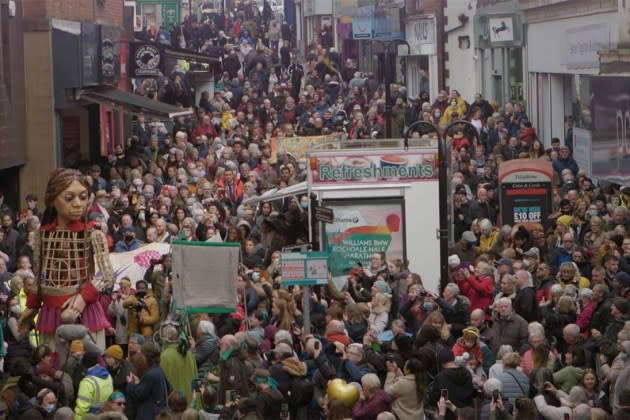‘The Walk’ Review: ‘Honeyland’ Director’s Effective Fusion of Political Urgency and Poetic Creativity

In her first feature documentary, the Oscar-nominated vérité marvel Honeyland, Tamara Kotevska shared the helm with Ljubomir Stefanov to illuminate a remote corner of the world. With her second film, she turns her attention to a headline story unfolding under all our noses, the global refugee crisis. Though the subject is more directly political this time around, the director has filtered it through a creative lens, fashioning what she calls a fairy tale. Like all good fairy tales, it offers a heightened version of reality, fusing the fantastic to the everyday. At its center is Little Amal, the 12-foot puppet of a 10-year-old Syrian refugee girl.
The Walk takes its name from an international project designed to raise awareness and funds to help displaced children. Amal and her puppeteers, led by artistic director Amir Nizar Zuabi, have traveled thousands of miles in more than a dozen countries since July 2021, and are now in Mexico after concluding a cross-country walk through the United States. But Kotevska’s doc is not about that project so much as it is a distillation of it, pairing Amal’s journey across Europe with the emblematic story of a real-life girl orphaned by war.
More from The Hollywood Reporter
Moving through city streets and village squares, and across uninhabited landscapes, Little Amal is a mechanical and artistic feat, impossible to ignore. Kotevska and editor Martin Ivanov condense the making-of aspect to a sprightly three minutes. Scenes of designing, painting, hammering, and puppeteer test runs at the Handspring Puppet Company (the South African outfit behind the puppets for the stage play War Horse) are intercut with glimpses of a young girl drawing Little Amal, a kind of self-portrait.
That girl, Asil Elsepti, having lost her home and family in Aleppo, is on the opposite side of the border now, under the care of the Karam Foundation in Turkey, and hopeful that she can find an uncle to take her in. Matching shots between the puppet girl and the real one emphasize their symbolic connection. Working from her conversations with Asil and other refugee children, the director has crafted a voiceover narration (delivered by another girl, not the Asil we see onscreen) that’s spare, poetic and searing. “I need to find a place where I can leave my nightmares behind,” Amal/Asil says.
Those bad dreams seep into the waking hours through sound and visuals, with a few brief bursts of footage that show bombs exploding and people scrambling in the aftermath. As Amal’s walk proceeds — from Turkey through Greece, Italy, France and Britain, where it wraps with an affecting operatic flourish at the English Channel, Kotevska inserts classroom scenes: Asil and other residents of the foundation learning about European geography and culture. (Their guesses about the predominant religion in Italy are a priceless reminder of the artificiality of so many of the divisions we cling to.)
Amal herself is seen interacting with nature as well as with people. The camerawork, led by Jean Dakar and Samir Ljuma, is alert to beauty all around, from the flutter of pigeons on a minaret to the rolling sweep of desert dunes, but also to the tents of displaced people on city streets, the aching hope in Asil’s gaze, and the psychic wounds carried by all the refugees Amal meets. The outsize little girl, so clearly nonhuman and yet so sympathetic, is an older-than-her-years figure of commiseration, a confessor to kids and adults in a refugee camp and, wrenchingly, to a man from Gambia who describes his journey to the Continent.
Three main puppeteers control Amal and guide her movements. The one in the open cage of her bodice, above the flouncing skirt, steers her usually confident, sometimes hesitant stride. At her hands are two puppeteers for whom, crucially, Amal’s trek across Europe has profound personal significance: Fidaa Zidan, from Palestine, and Mouaiad Roumieh, from Syria. Kotevska spends time with each of them and delves gently into their stories, with poignant impact.
As the fairy tale that the filmmaker has constructed for Amal/Asil hits moments of despair (after encountering anti-immigration demonstrations in Greece, for example), the puppeteers’ faces reveal how deeply they feel her struggle — Fidaa in terms of her people’s loss of land and freedom, Mouaiad in terms of being torn from his home and how his memories of it are fading. In a voiceover musing that can’t help but bring to mind the ongoing devastation in Gaza, Amal/Asil wonders, “When all that’s left is dust and rubble, will anyone know we ever existed?”
Keenly aware of the scale and theatricality of Amal’s trip, and her role as a stand-in for millions (almost half the world’s refugees are younger than 18), The Walk frames its story in terms of the power of symbols, and also their limitations. A visit with the pope during a ceremony celebrating children captures both ends of that spectrum, and a formal presentation by the human rights organization the Council of Europe makes painfully clear the limitation end of the bargain: Representatives of the group give Amal a council flag and a passport, urging her to share it with children she meets.
Empty gestures notwithstanding, the children Amal encounters tend to greet her with wonder and delight. Some adults eye her like a Trojan horse, some express anger, and others eagerly join her cause to spread the word. Shining a light on a story that moves into and out of the news media’s attention, The Walk opts not for speechifying or arguing. It honors, rather, the kernel of life a puppet can embody, built by hand and sprung straight from the heart.
Best of The Hollywood Reporter

 Yahoo News
Yahoo News 